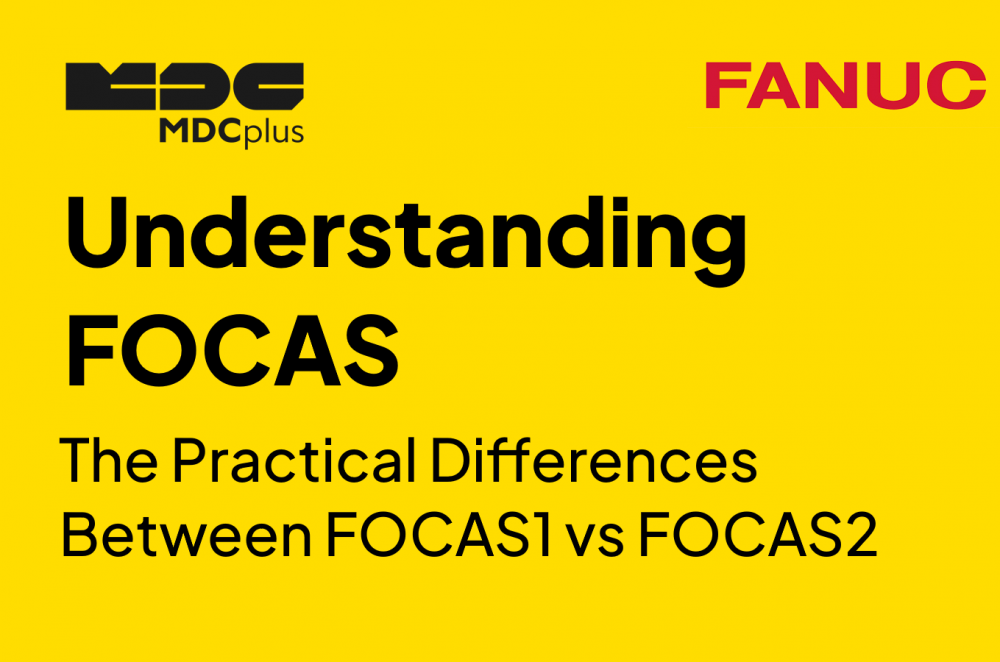Understanding FOCAS: The Practical Differences of FOCAS1 vs FOCAS2
In Part 1 of our FOCAS Tech Guide, we covered what the FOCAS library is, how it works, and why it’s the go-to for pulling data from FANUC controls. Now it’s time to address a common source of confusion: FOCAS1 vs FOCAS2. These aren’t just version numbers – they represent two different generations of connectivity.
1. Connection Method
-
FOCAS1 – Uses HSSB (High-Speed Serial Bus). Requires a dedicated FANUC HSSB interface card on the CNC and a matching PC card. Proprietary cable, limited cable length, no IP networking.
-
FOCAS2 – Uses Ethernet TCP/IP. Requires the Ethernet FOCAS option enabled on the CNC, but no special hardware on the PC side. Standard LAN cables, switchable, routable.
Why it matters:
FOCAS2 can ride on existing plant networks. You can connect through switches, routers, and even securely over VPN. FOCAS1 is point-to-point, physically limited, and harder to scale.
2. Supported FANUC Controls
-
FOCAS1 – Targets older 0i, 16i, 18i, 21i series from the HSSB era.
-
FOCAS2 – Supports all Ethernet-capable FANUC controls, including the 0i-F/0i-MF and the 30i/31i/32i families.
If your machines will be upgraded in the next few years, FOCAS2 ensures you won’t have to redesign your integration.
3. Available Functions
FOCAS2 brings more than just a transport change:
-
Data Server access – file storage, program streaming, M198 host calls.
-
ATA card and memory card management.
-
Multi-channel support for complex lathes and multitasking machines.
-
Expanded diagnostic and status functions, especially in maintenance-related data.
FOCAS1’s API is frozen – you’ll only have the functions documented years ago.
4. Deployment and Maintenance
-
FOCAS1 – Requires installing FANUC’s HSSB drivers on the PC and using a supported PCI/PCIe card.
-
FOCAS2 – Only needs the FOCAS DLL (
fwlib32.dllorfwlib64.dll) and a network connection.
FOCAS2 is lighter to deploy. Adding another PC for data collection is as simple as plugging into the network.
5. Licensing
Both require FANUC-issued options:
-
FOCAS1 – Licensed per CNC with HSSB hardware.
-
FOCAS2 – Licensed per CNC with Ethernet FOCAS enabled.
Developer kits are different SKUs, so make sure you order the right one.
6. Ecosystem Support
Most MES, MDC, and OPC-UA connectors built in the last decade default to FOCAS2. Documentation, sample code, and vendor expertise are heavily skewed towards Ethernet implementations. FOCAS1 support exists, but it’s increasingly niche.
Which Should You Use?
-
FOCAS1 – Only if you’re dealing with legacy controls that can’t be retrofitted with Ethernet.
-
FOCAS2 – Use it for any new integration. It’s faster to deploy, easier to maintain, and more future-proof.
TL;DR:
FOCAS1 is the legacy HSSB-based API – hardware-bound, point-to-point, and only for older controls. FOCAS2 is the Ethernet-based, feature-rich successor – faster to deploy, easier to maintain, and future-proof for modern FANUC CNCs.
Comparison Table – FOCAS1 vs FOCAS2
| Feature / Aspect | FOCAS1 | FOCAS2 |
|---|---|---|
| Transport | HSSB (High-Speed Serial Bus) | Ethernet TCP/IP |
| PC Hardware | Requires FANUC HSSB PCI/PCIe card | No special hardware – standard NIC |
| CNC Option Required | HSSB board + FOCAS1 option | Ethernet port + Ethernet FOCAS option |
| Supported Controls | Older 0i, 16i, 18i, 21i | Modern Ethernet-capable 0i-F, 30i/31i/32i |
| Cable Length | Limited, direct connection only | Standard LAN limits (100m) – extendable |
| Network Routing | No – point-to-point only | Yes – can route through switches/routers/VPN |
| Available Functions | Fixed, no new features | Expanded set – Data Server, ATA, multi-channel |
| Deployment Complexity | High – drivers + dedicated card installation | Low – copy DLL and connect via LAN |
| Ecosystem Support | Legacy integrations only | Standard for modern MES/MDC solutions |
| Future-proofing | None – frozen API | High – actively maintained and extended |
About MDCplus
Our key features are real-time machine monitoring for swift issue resolution, power consumption tracking to promote sustainability, computerized maintenance management to reduce downtime, and vibration diagnostics for predictive maintenance. MDCplus's solutions are tailored for diverse industries, including aerospace, automotive, precision machining, and heavy industry. By delivering actionable insights and fostering seamless integration, we empower manufacturers to boost Overall Equipment Effectiveness (OEE), reduce operational costs, and achieve sustainable growth along with future planning.
Ready to increase your OEE, get clearer vision of your shop floor, and predict sustainably?
